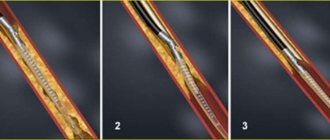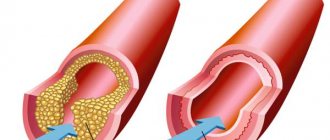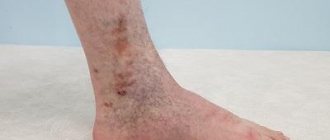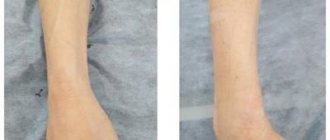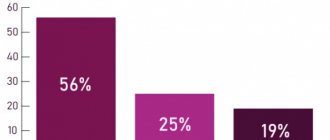The drug Trental, which improves blood circulation, is produced in the form of tablets and a concentrated solution for infusion. The cost of the medicine depends on the form of the medicine and packaging. You can buy Trental at a price of 100-300 rubles per package.
The active substance in pentoxifylline is a xanatine derivative. The component is contained in the following quantities:
- 100 mg, 400 mg in soluble film-coated tablets.
- 20 mg in one ml solution for infusion.
In order to exclude possible allergic reactions when taking the product, it is necessary to pay attention to the auxiliary components that were used to create the drug. Trental instructions also contain all recommendations for use and focus on contraindications.
Causes
The main cause of atherosclerosis of the vessels of the lower extremities is a violation of lipid metabolism - an increase in the level of cholesterol in the blood, and especially its “dangerous” fraction of low-density lipoproteins (LDL). However, an increase in high-density lipoproteins (HDL) does not cause atherosclerosis.
Elevated cholesterol levels alone are not enough to cause the disease. There must also be risk factors that affect the vulnerability of the artery wall, its protective properties, etc. These include:
- Smoking is the most dangerous risk factor and needs to be discussed separately. Even smoking several cigarettes a day leads to damage to the vascular endothelium; with high cholesterol, this gives a high risk of cholesterol deposition at the site of the lesion and the beginning of plaque formation. When smoking a large number of cigarettes per day, this risk increases significantly.
- Hypertonic disease
- Overweight
- Diabetes
- Alcohol abuse
What is reticular varicose veins
In the human body, blood circulates through arteries, veins, capillaries, and venules. Arteries are the largest vessels of the circulatory system. They connect to the veins. The smallest vessels are venules. On the lower extremities, superficial intermediate venous vessels are visible under the skin. Their diameter is greater than the diameter of the capillaries, but less than the diameter of the main veins. This venous network is called reticular. In other words, reticular veins are small millimeter-sized vessels that are visible under the skin of the legs.
Every vein has valves. They filter the direction of blood movement and its volume. The reticular vein has only one valve. If it is deformed, the vein expands, twists and carries a larger volume of blood. Venous pressure in the retinal layer of the skin increases due to the accumulation of blood in a certain area. Valve insufficiency develops and reticular varicose veins form - a plexus of small vessels of red, blue, purple color, visible through the skin.
Symptoms, diagnosis
The main and earliest symptom of obliterating atherosclerosis of the arteries of the lower extremities is intermittent claudication. When walking a certain distance, the patient begins to feel fatigue, heaviness in one or both legs, and then pain, forcing him to stop and continue moving after a short rest.
The stage of the disease is even determined by the length of the pain-free walking distance. From 500 m to 1 km – stage 1, from 200 to 500 m – stage 2A, less than 200 m – stage 2B, less than 50 m and pain at rest – stage 3. Stage 4 of atherosclerosis of the extremities is gangrene.
When examining the patient, attention is drawn to a decrease in the calf muscles, dystrophy of the nail plates, and a decrease in the amount of hair on the legs. A characteristic symptom is the absence of pulse in the feet, popliteal, and femoral arteries (depending on the level of the lesion).
Important methods for diagnosing atherosclerosis of the vessels of the lower extremities are ultrasound (ultrasound ultrasound, doppler ultrasound, duplex angioscanning), angiography.
Contraindications
An absolute contraindication is intolerance to the active substance and other components in the medication. The drug is not prescribed for people under the age of 18, as well as during pregnancy and lactation. Other contraindications for Trental 100, the instructions for use focus on:
- Severe bleeding of any etiology.
- Hemorrhages in the brain and retina.
- Myocardial infarction.
With extreme caution and only after assessing the patient’s condition, the drug is prescribed for the following pathologies:
- Cardiac arrhythmia.
- Low blood pressure.
- Chronic heart failure.
- Stomach and duodenal ulcers.
- Kidney failure.
- Liver pathologies.
Do not use the medicine after surgery, or if you are prone to bleeding.
Treatment of atherosclerosis of the vessels of the lower extremities
Lifestyle changes, non-drug treatment
Patients with atherosclerosis of the arteries of the extremities, as a rule, need to change their lifestyle.
First of all, you need a COMPLETE cessation of smoking. Reducing the number of cigarettes smoked, of course, has a positive effect on the course of the disease, but the risk of damage to the vascular wall still remains.
Overweight patients need to lose weight.
An important factor in reducing blood cholesterol levels (especially its dangerous fractions - LDL) is following a diet low in animal fats.
Patients suffering from hypertension and diabetes mellitus need to be monitored by an appropriate specialist (therapist, endocrinologist) to correct these diseases.
Against the background of drug correction, training for the development of collateral circulation is desirable. The fact is that with obliterating atherosclerosis, the main vessels are affected. In this case, blood circulation begins to occur through small bypass (collateral) vessels. With good development of collateral circulation, limb ischemia can be minimized even with complete closure of the lumen of the main artery. Along with medications that help improve collateral circulation (they will be discussed below), training walking is used using special techniques on a treadmill and just on foot.
Recommendations for training walking: patients are recommended to walk 2-3 hours a day, not at a fast pace, so that there is no pain in the legs. At the same time they exercise on a treadmill. They start by selecting a walking speed along the path that does not cause fatigue in the legs for at least 10 minutes of continuous walking. Then increase the speed by 0.5 km/h. They begin walking at this speed, when fatigue and pain in the lower leg appear, they rest until the discomfort completely disappears, then they resume walking again until discomfort appears. The average walking time on the path is 30-40 minutes per day. The goal is to increase the distance of pain-free walking to 1.5 km, after which the walking speed is increased by another 0.5 km/h, etc. Training should be done under the supervision of a doctor.
Dosage
The dose and method of administration are determined by the doctor after examining the patient. In this case, the severity of the circulatory disorder against the background of a specific disease and the person’s condition must be taken into account. Treatment must be carried out under strict control of blood pressure.
According to the instructions attached to the drug, oral administration is permitted in accordance with the following recommendations:
- Treatment intake: 3 tablets (100 mg) three times a day.
- Possible increase in dosage to 6 (100 mg) tablets three times a day.
- The maximum single dose is no more than 2 (100 mg) tablets.
Tablets are usually indicated for maintenance therapy. They are taken after meals. They must be swallowed with plenty of clean water. If there are pathologies of the kidneys and liver, then the dosage is reduced by 2 times. There are also other recommendations in the instructions that need to be studied.
The infusion solution is prepared from 100 - 600 mg of medication. It is diluted in 0.9% sodium chloride solution (250 - 500 ml). Droppers are placed 1-2 times a day. It is imperative to test for compatibility when using other infusion solutions.
Drug treatment
There are many medications that are used for obliterating atherosclerosis of the lower extremities.
They can be divided into several groups:
- Antiplatelet agents - thrombo ACC, cardiomagnyl, trental, plavix, reopoliglucin.
- Drugs that reduce blood viscosity - vesel due f (sulodexide), phlogenzyme, wobenzym.
- Agents that improve peripheral blood circulation and microcirculation - alprostan (vasoprostan), nicotinic acid, xanthinol nicotinate.
- Agents that promote the development of collateral circulation - Actovegin, solcoseryl.
- Drugs that lower blood cholesterol levels - Torvacard, Crestor, etc.
- Other medicines – chimes, analgesics (for pain), antibiotics (for purulent-necrotic ulcers), etc.
Typically, patients are permanently prescribed one of the acetylsalicylic acid drugs for life - thrombo-ass or cardiomagnyl. Other drugs are prescribed in courses, depending on the stage of the disease and clinical manifestations.
It is believed that twice a year patients require hospitalization in the vascular surgery department for courses of conservative therapy - intravenous infusions, hyperbaric oxygen therapy, physical therapy.
Effects of the drug and indications
The drug trental, the instructions for use indicate, reduces blood viscosity and improves its fluidity. The active substance has a slight myotropic vasodilator effect. Such combinations of properties help, after taking the drug, to improve microcirculation in areas where circulatory disorders are observed. The active substance in the medicine is quickly absorbed into the gastrointestinal tract, which guarantees a quick effect. When smoking, the therapeutic effect of the drug is significantly reduced.
Trental tablets are indicated for use in cases of impaired peripheral circulation due to the development of atherosclerosis. Its effectiveness has been proven in a pathology known as “intermittent” claudication. This insidious pathology can immobilize a person at any time. Its main symptom is acute pain in the legs, caused by deterioration of blood circulation in the arteries and their narrowing.
Trental 100 is also prescribed, the instructions confirm this, for trophic disorders. The medicine alleviates the condition of patients with trophic ulcers, which often occur against the background of varicose veins and thrombophlebitis. The drug is indicated in the complex treatment of gangrene and frostbite.
It is recommended to use trental for cerebrovascular accidents. This pathology can be provoked by cerebral atherosclerosis. Symptoms of the disease are the following:
- Inability to concentrate.
- The occurrence of periodic dizziness.
- Problems remembering simple information.
Ischemic and post-stroke conditions are also indications for the drug. When using the drug, it is possible to improve the condition of patients against the background of rapid restoration of blood flow. Indications are degenerative changes in pathologies of the vessels of the inner ear, which lead to hearing loss.
Surgery
Surgical treatment is possible in the presence of narrowings (stenoses) of large vessels, mainly in the popliteal-femoral segment or above. Reconstructive operations for damage to the arteries of the leg are practically not used.
For small stenoses, stenting is possible - installing a stent in the area of stenosis in a minimally invasive way (through a puncture in the femoral artery), which restores the patency of the artery.
In case of significant narrowings, reconstructive operations on blood vessels are used - bypass surgery, prosthetics.
With timely and correct treatment of obliterating atherosclerosis of the vessels of the lower extremities, it is most often possible to stabilize the process and avoid late complications - trophic ulcers, gangrene.
Adverse reactions
When the medicine is used correctly, adverse reactions of the body are rarely observed. As a rule, negative reactions occur when contraindications are violated, an overdose or non-compliance with the infusion rate.
The most common side effects occur from the nervous system. They may manifest as headaches. Negative reactions are also often associated with insomnia and internal anxiety.
Sometimes swelling and redness of the skin of the face may appear. In severe cases, an overdose develops tachycardia or arrhythmia, as well as other disruptions in the functioning of the cardiovascular system. Severe allergic reactions and signs of gastrointestinal bleeding may occur.
If dangerous symptoms appear and the general condition worsens, you should stop taking the drug. Treatment is symptomatic. If the patient’s condition cannot be stabilized, an ambulance should be called.
The danger of reticular varicose veins
In many cases, patients do not pay attention to spider veins and do not rush to see a doctor. There are practically no symptoms, so women attribute the visibility of veins to a cosmetic defect.
If treatment is not started at the initial stage, valvular insufficiency of the deep main veins will develop. Reticular varicose veins of the GSV tributaries are especially dangerous. The great saphenous vein runs along the medial side of the legs and connects with the femoral vein. As the GSV valves deform, varicose veins develop.
If the problem is ignored for a long time, the vascular network deepens and the risk of trophic ulcers increases.
Causes and risk factors for the development of reticular varicose veins
Most often the disease is observed in women. The trigger mechanism is hemodynamic disturbance. Due to the fact that the valve is deformed, blood begins to circulate in the opposite direction. The plexus of blood vessels becomes overcrowded, and the blood stagnates. Because of this, the walls of the blood vessels expand, become brighter and more noticeable through the skin.
This condition may be preceded by:
- Hormonal surge. A decrease in estrogen and an increase in progesterone leads to a loss of venous tone and expansion of the lumen of blood vessels, rapid blood clotting, and a decrease in antithrombin in plasma. Phlebopathy develops. This process is often observed in pregnant women, as well as in women who take oral contraceptives.
- Heredity. Changes in connective tissue are transmitted through the female line, therefore, with varicose veins in a mother or grandmother, the risk of dilation of reticular vessels increases at a young age.
- Load on the legs. In people who work sitting or standing, the diagnosis is made more often. Reticular varicose veins of both extremities are observed in office workers, accountants, loaders, hairdressers, and teachers.
- Frequent air travel. During air travel, due to changes in atmospheric pressure, vascular tone and blood flow in the reticularities change.
The development of the disease is aggravated by smoking, obesity, arterial hypertension, second and subsequent pregnancy, taking corticosteroids, liver cirrhosis, systemic scleroderma.


